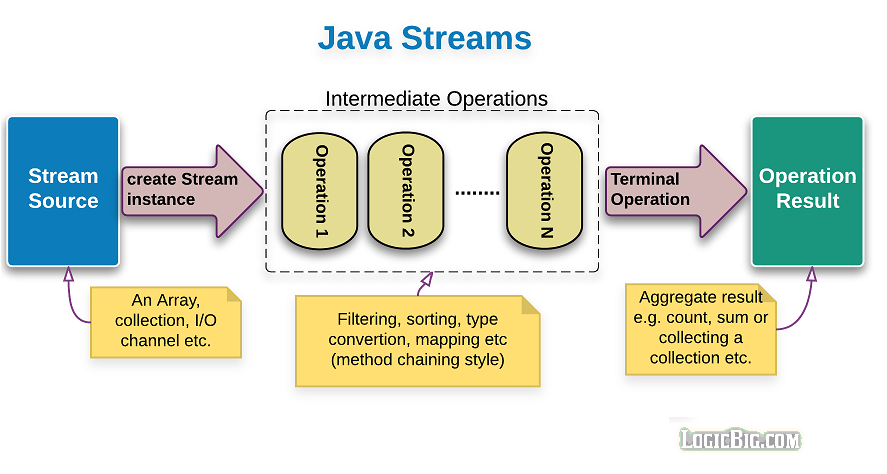In the fast-paced world of software development, a decade can feel like an eternity. Java 8, released in 2014, is now a veteran in the language landscape. So, why are we still discussing Java 8 news? The answer is simple: its release wasn’t just an update; it was a revolution that fundamentally reshaped the Java ecosystem. The features introduced in Java 8—Lambdas, the Stream API, Optional, and a new Date-Time API—are not historical footnotes. They are the foundational pillars upon which modern Java, from version 11 to 21 and beyond, is built.
For countless enterprise applications, Java 8 remains the long-term support (LTS) version of choice, making it a critical skill for millions of developers. More importantly, understanding these core features is essential for integrating legacy systems with cutting-edge technologies, from reactive microservices to AI-powered data stores. This article delves into the enduring relevance of Java 8’s key features, demonstrating how they continue to drive clean, efficient, and robust code in today’s demanding software environment. We will explore how mastering these concepts is not just about maintaining old code, but about writing better, more future-proof Java, regardless of the version you use.
The Lambda Revolution: Writing Cleaner, More Expressive Code
The single most transformative feature of Java 8 was the introduction of lambda expressions. Before Java 8, implementing simple, single-method interfaces required cumbersome anonymous inner classes. This verbosity often cluttered the code and obscured the developer’s intent. Lambdas provided a clean, concise syntax for providing an implementation for a functional interface.
What are Lambdas and Functional Interfaces?
A lambda expression is essentially an anonymous function—a block of code that you can pass around and execute later. It allows you to treat functionality as a method argument, or code as data. This is made possible by functional interfaces, which are interfaces that contain exactly one abstract method. The @FunctionalInterface annotation can be used to ensure this contract at compile time.
Common examples include Runnable, Callable, and Comparator. Java 8 also introduced a new package, java.util.function, filled with new functional interfaces like Predicate, Consumer, Function, and Supplier to cover common use cases.
Practical Example: Simplifying Event Listeners and Sorting
Let’s look at a classic “before and after” scenario. Imagine you have a list of Employee objects and you want to sort them by salary in descending order. The pre-Java 8 approach using an anonymous inner class is quite verbose.
// Employee record for concise data representation (a modern Java feature)
public record Employee(String name, double salary, String department) {}
// Main class to demonstrate sorting
public class EmployeeSorter {
public static void main(String[] args) {
List<Employee> employees = Arrays.asList(
new Employee("Alice", 90000, "Engineering"),
new Employee("Bob", 120000, "Engineering"),
new Employee("Charlie", 85000, "HR"),
new Employee("David", 110000, "Sales")
);
// Before Java 8: Using an anonymous inner class
Collections.sort(employees, new Comparator<Employee>() {
@Override
public int compare(Employee e1, Employee e2) {
return Double.compare(e2.getSalary(), e1.getSalary()); // Descending
}
});
System.out.println("Sorted with Anonymous Class:");
employees.forEach(System.out::println);
// With Java 8: Using a lambda expression
// Re-initialize for a clean comparison
List<Employee> employeesForLambda = new ArrayList<>(employees);
employeesForLambda.sort((e1, e2) -> Double.compare(e2.getSalary(), e1.getSalary()));
// Even more concise with Comparator helper methods
employeesForLambda.sort(Comparator.comparingDouble(Employee::getSalary).reversed());
System.out.println("\nSorted with Lambda and Comparator Helper:");
employeesForLambda.forEach(System.out::println);
}
}The lambda version is not just shorter; it’s clearer. The intent—sorting by comparing two salaries—is immediately obvious, free from the boilerplate of the anonymous class. This is one of the most important pieces of Java wisdom tips news from that era: focus on the “what,” not the “how.”
Mastering Data with the Stream API

Building directly on the power of lambdas, the Stream API introduced a declarative, fluent way to process collections of data. Instead of writing explicit loops (imperative programming), developers can now create a pipeline of operations to transform and aggregate data.
From Loops to Pipelines
A stream is not a data structure; it’s a sequence of elements from a source (like a List or an array) that supports aggregate operations. Stream operations are divided into two categories:
- Intermediate Operations: These return a new stream and are always lazy. Examples include
filter()(to select elements based on a condition),map()(to transform elements), andsorted(). - Terminal Operations: These trigger the processing of the stream and produce a result or a side-effect. Examples include
collect()(to put results into a collection),forEach()(to iterate), andreduce()(to combine elements into a single result).
This pipeline approach, combined with laziness, allows the JVM to perform significant optimizations. It also opens the door to easy parallelization with parallelStream(), a key topic in Java concurrency news.
Real-World Application: Processing and Analyzing E-Commerce Orders
Imagine you have a list of e-commerce orders and you need to calculate the total revenue from all “COMPLETED” orders in the “Electronics” category placed in the last month. Using the Stream API, this complex query becomes an elegant and readable pipeline.
import java.time.LocalDateTime;
import java.util.Arrays;
import java.util.List;
// Enum for order status
enum OrderStatus { PENDING, COMPLETED, CANCELLED }
// Record for an Order
public record Order(String orderId, LocalDateTime orderDate, String category, double amount, OrderStatus status) {}
public class OrderProcessor {
public static void main(String[] args) {
List<Order> orders = Arrays.asList(
new Order("A101", LocalDateTime.now().minusDays(5), "Electronics", 250.00, OrderStatus.COMPLETED),
new Order("A102", LocalDateTime.now().minusDays(10), "Books", 55.50, OrderStatus.COMPLETED),
new Order("A103", LocalDateTime.now().minusDays(2), "Electronics", 1200.00, OrderStatus.PENDING),
new Order("A104", LocalDateTime.now().minusDays(15), "Electronics", 499.99, OrderStatus.COMPLETED),
new Order("A105", LocalDateTime.now().minusMonths(2), "Electronics", 800.00, OrderStatus.COMPLETED),
new Order("A106", LocalDateTime.now().minusDays(20), "Groceries", 75.20, OrderStatus.COMPLETED)
);
LocalDateTime oneMonthAgo = LocalDateTime.now().minusMonths(1);
double totalElectronicsRevenueLastMonth = orders.stream()
// Keep only completed electronics orders
.filter(order -> "Electronics".equals(order.category()) && order.status() == OrderStatus.COMPLETED)
// Keep only orders from the last month
.filter(order -> order.orderDate().isAfter(oneMonthAgo))
// Map the stream of Orders to a stream of their amounts (doubles)
.mapToDouble(Order::amount)
// Sum the amounts
.sum();
System.out.printf("Total revenue from completed electronics orders in the last month: $%.2f%n", totalElectronicsRevenueLastMonth);
}
}This code is self-documenting. Each line in the pipeline clearly states its purpose. Trying to achieve this with nested loops and `if` statements would result in more complex, error-prone code. This declarative style is a precursor to modern Reactive Java news and frameworks like Project Reactor and RxJava.
Modernizing Code Safety and Date Handling
Beyond the headline features of Lambdas and Streams, Java 8 also delivered two massive quality-of-life improvements that address common sources of bugs: null pointer exceptions and date/time manipulation.
Escaping the Billion-Dollar Mistake with `Optional`
NullPointerException is arguably the most infamous error in Java. Java 8 introduced the java.util.Optional<T> class to provide a better way to handle values that might be absent. It’s a container object that either holds a non-null value or nothing. It forces the developer to consciously consider the “not present” case, moving null checks from a runtime concern to a compile-time, type-system-level concern.
Instead of returning null, a method can return an Optional. The caller can then use methods like ifPresent(), orElse(), and map() to safely work with the value. This aligns well with the Null Object pattern news and promotes more robust, secure code, which is always a hot topic in Java security news.

A New Era for Dates and Times
The old java.util.Date and Calendar APIs were mutable, not thread-safe, and had a confusing, non-intuitive design. Java 8 replaced them entirely with the new java.time package (based on the popular Joda-Time library). This new API is immutable, thread-safe, and based on the ISO-8601 standard. It provides clear, specific classes for different use cases: LocalDate, LocalTime, LocalDateTime, ZonedDateTime, Duration, and Period.
Combined Example: Safely Finding a User and Checking Their Subscription
Let’s combine these two features. We’ll create a method that might fail to find a user. If the user is found, we’ll check if their subscription is still active.
import java.time.LocalDate;
import java.util.HashMap;
import java.util.Map;
import java.util.Optional;
// User record
public record User(int id, String username, LocalDate subscriptionEndDate) {}
// A mock repository to find users
public class UserRepository {
private static final Map<Integer, User> userDatabase = new HashMap<>();
static {
userDatabase.put(1, new User(1, "alice", LocalDate.now().plusMonths(6)));
userDatabase.put(2, new User(2, "bob", LocalDate.now().minusDays(10))); // Expired
}
public Optional<User> findById(int id) {
return Optional.ofNullable(userDatabase.get(id));
}
}
public class SubscriptionService {
public static void main(String[] args) {
UserRepository repository = new UserRepository();
// --- Check user 1 (exists and is active) ---
int userId1 = 1;
String status1 = repository.findById(userId1)
// If user is present, map them to a boolean indicating if subscription is active
.map(user -> user.subscriptionEndDate().isAfter(LocalDate.now()))
// If the boolean is true, map to "Active", otherwise "Expired"
.map(isActive -> isActive ? "Active" : "Expired")
// If the user was not found at all, provide a default value
.orElse("User Not Found");
System.out.printf("Subscription status for user %d: %s%n", userId1, status1);
// --- Check user 2 (exists but expired) ---
int userId2 = 2;
String status2 = repository.findById(userId2)
.map(user -> user.subscriptionEndDate().isAfter(LocalDate.now()))
.map(isActive -> isActive ? "Active" : "Expired")
.orElse("User Not Found");
System.out.printf("Subscription status for user %d: %s%n", userId2, status2);
// --- Check user 3 (does not exist) ---
int userId3 = 3;
String status3 = repository.findById(userId3)
.map(user -> user.subscriptionEndDate().isAfter(LocalDate.now()))
.map(isActive -> isActive ? "Active" : "Expired")
.orElse("User Not Found");
System.out.printf("Subscription status for user %d: %s%n", userId3, status3);
}
}Java 8 in the Modern Ecosystem: Relevance and the Road Ahead
While newer versions like Java 17 news and Java 21 news bring exciting features like records, sealed classes, and virtual threads, Java 8’s influence persists. Many of the most popular frameworks, including those covered in Spring news and Hibernate news, heavily leverage Java 8’s functional capabilities in their APIs.
Why Java 8 Persists

The primary reason for Java 8’s longevity is its status as a Long-Term Support (LTS) release with widespread industry adoption and stability. Major JVM news distributors, from Oracle Java news to open-source alternatives like Adoptium news, Azul Zulu news, and Amazon Corretto news, continue to provide security patches and support for Java 8. This makes it a safe, reliable choice for large-scale enterprise systems where stability is paramount.
Bridging the Gap to Modern Java
The functional programming paradigm championed by Java 8 paved the way for the future of Java concurrency. The latest Project Loom news, which delivered virtual threads in Java 21, aims to simplify high-throughput concurrent applications. While virtual threads are a new model, the declarative style of Streams and CompletableFuture from Java 8 trained developers to think in terms of tasks and data flows, a mindset that is highly compatible with modern concurrency patterns like Java structured concurrency news.
Furthermore, the vibrant Java ecosystem news shows that modern libraries are being built with Java 8 compatibility in mind. Whether it’s a new asynchronous database driver or an AI integration library like LangChain4j, maintainers understand the need to support the vast Java 8 user base. This ensures that even applications running on this older LTS version can interface with the latest technologies, driving ongoing innovation.
Conclusion
To dismiss Java 8 as “old news” is to miss the point entirely. The features it introduced were so profound that they became the new baseline for the language. Lambdas and Streams are now the idiomatic way to handle data processing. `Optional` is the standard for null-safe API design, and the `java.time` package is the undisputed champion of date and time manipulation.
For developers, mastering these Java 8 features is not optional; it is essential. They provide the vocabulary for writing modern, readable, and robust Java code. While the community should absolutely look forward to the performance gains and language enhancements in Java 17, 21, and beyond—exploring future advancements from Project Panama news and Project Valhalla news—it all starts with the solid foundation laid a decade ago. The legacy of Java 8 is not in its version number, but in the powerful, functional, and expressive paradigm it gifted to the entire Java world.

